Les Rougon-Macquart
Les Rougon-Macquart [le ʁu.ɡɔ̃ ma.kaʁ] is the collective title given to a cycle of twenty novels by French writer Émile Zola. Subtitled Histoire naturelle et sociale d'une famille sous le Second Empire (Natural and social history of a family under the Second Empire), it follows the lives of the members of the two titular branches of a fictional family living during the Second French Empire (1852–1870) and is one of the most prominent works of the French naturalism literary movement.
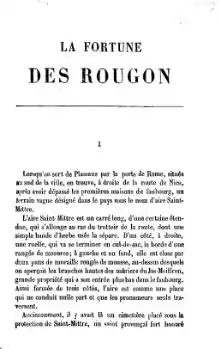 First page of La Fortune des Rougon, the first book of the series | |
20 books, see this list | |
| Author | Émile Zola |
|---|---|
| Country | France |
| Language | French |
| Genre | Naturalism |
| Published | 1871–1893 |
| Media type | |
Influences
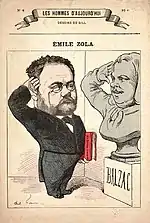
Early in his life, Zola discovered the work of Honoré de Balzac and his famous cycle La Comédie humaine. This had a profound impact on Zola, who decided to write his own, unique cycle. However, in 1869, he explained in Différences entre Balzac et moi, why he would not make the same kind of book as Balzac:
In one word, his work wants to be the mirror of the contemporary society. My work, mine, will be something else entirely. The scope will be narrower. I don't want to describe the contemporary society, but a single family, showing how the race is modified by the environment. (...) My big task is to be strictly naturalist, strictly physiologist.[1]
As a naturalist writer, Zola was highly interested by science and especially the problem of heredity and evolution. He notably read and mentioned the work of the doctor Prosper Lucas,[2] Claude Bernard, and Charles Darwin[3] as references for his own work. This led him to think that people are heavily influenced by heredity and their environment. He intended to prove this by showing how these two factors could influence the members of a family. In 1871, in the preface of La Fortune des Rougon, he explained his intent:
The great characteristic of the Rougon-Macquarts, the group or family which I propose to study, is their ravenous appetite, the great outburst of our age which rushes upon enjoyment. Physiologically the Rougon-Macquarts represent the slow succession of accidents pertaining to the nerves or the blood, which befall a race after the first organic lesion, and, according to environment, determine in each individual member of the race those feelings, desires and passions—briefly, all the natural and instinctive manifestations peculiar to humanity—whose outcome assumes the conventional name of virtue or vice.[4]
Preparations
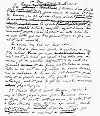
In a letter to his publisher, Zola stated his goals for the Rougon-Macquart: "1° To study in a family the questions of blood and environments. [...] 2° To study the whole Second Empire, from the coup d'état to nowadays."[5]
Genealogy and heredity
Since his first goal was to show how heredity can affect the lives of descendants, Zola started working on the Rougon-Macquart by drawing the family tree for the Rougon-Macquart. Though it was to be modified many times over the years, with some members appearing or disappearing, the original tree shows how Zola planned the whole cycle before writing the first book.
The tree provides the name and date of birth of each member, along with certain properties of his heredity and his life:
- The prepotency : The prepotency is a term used by the doctor Lucas. It is part of a biological theory that tries to determine how heredity transmits traits through generations.[6] Zola apply this theory to the mental state of his protagonists and uses terms from the work of the doctor Lucas: Election du père (Prepotency of the father, meaning the father is the main influence on the child), Election de la mère (Prepotency of the mother), Mélange soudure (Fusion of the 2 parents) or Innéité (No influence from either parent).
- Physical likeness: Whether the member looks like his mother or his father.
- Biographical information: his job and important facts of his life. Additionally, for members still living at the end of Le Docteur Pascal, their place of living at the end of the cycle may be included. Otherwise, the date of death is included.
 The 1878 tree, published in a note included in Une Page d'amour
The 1878 tree, published in a note included in Une Page d'amour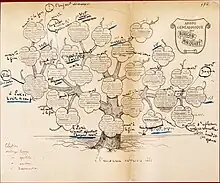 The 1892 and final tree, annotated by Zola and which published in 1893 with his final novel Le Docteur Pascal[7]
The 1892 and final tree, annotated by Zola and which published in 1893 with his final novel Le Docteur Pascal[7] A late "mathematical" tree drawn by Georges Pouchet. This was included in Zola's preparatory dossier for the final novel Le Docteur Pascal published in 1893 . Each ancestor has a color, and each child is influenced by one or more of their ancestors.[8]
A late "mathematical" tree drawn by Georges Pouchet. This was included in Zola's preparatory dossier for the final novel Le Docteur Pascal published in 1893 . Each ancestor has a color, and each child is influenced by one or more of their ancestors.[8]
Note: the gallery does not include the tree made for La Bete Humaine[9] which included for the first time Jacques, the main protagonist of the book[10]
For example, the entry for Jean Macquart on the 1878 tree read: Jean Macquart, né en 1831 - Election de la mère - Ressemblance physique du père. Soldat (Jean Macquart, born in 1831 - Prepotency of the mother - Physical likeness to his father. Soldier)
The study of the Second Empire
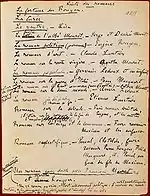
To study the Second Empire, Zola thought of each novel as a novel about a specific aspect of the life in his time. For example, in the list he made in 1872, he intended to make a "political novel", a "novel about the defeat", "a scientific novel", and a "novel about the war in Italy". The first three ideas led to Son Excellence Eugène Rougon, La Débâcle, and Le Docteur Pascal, respectively. However, the last idea would never be made into a book.
Indeed, at the beginning, Zola did not know exactly how many books he would write. In the first letter to his publisher, he mentioned "ten episodes".[5] In 1872, his list included seventeen novels, but some of them would never be made (such as the one on the war in Italy), whereas others were to be added later on.[11] In 1877, in the preface of L'Assommoir, he stated that he was going to write "about twenty novels".[12] In the end, he settled for twenty books.
Story
Almost all of the main protagonists for each novel are introduced in the first book, La Fortune des Rougon. The last novel in the cycle, Le Docteur Pascal, contains a lengthy chapter that ties up loose ends from the other novels. In between, there is no "best sequence" in which to read the novels in the cycle, as they are not in chronological order and indeed are impossible to arrange into such an order. Although some of the novels in the cycle are direct sequels to one another, many of them follow on directly from the last chapters of La Fortune des Rougon, and there is a great deal of chronological overlap between the books; there are numerous recurring characters and several of them make "guest" appearances in novels centered on other members of the family.
The Rougon-Macquart
The Rougon-Macquart family begins with Adelaïde Fouque. Born in 1768 in the fictional Provençal town Plassans to middle-class parents (members of the French "bourgeoisie"), she has a slight intellectual disability. She marries Rougon, and gives birth to a son, Pierre Rougon. However, she also has a lover, the smuggler Macquart, with whom she has two children: Ursule and Antoine Macquart. This means that the family is split in three branches:
- The first, legitimate, one is the Rougons branch. They are the most successful of the children. Most of them live in the upper classes (such as Eugene Rougon who becomes a minister) or/and have a good education (such as Pascal, the doctor who is the main protagonist of Le Docteur Pascal).
- The second branch is the low-born Macquarts. They are urban working-class (L'Assommoir), farmers (La Terre), or soldiers (La Débâcle).
- The third branch is the Mourets (the name of Ursule Macquart's husband). They are a mix of the other two. They are middle-class people (bourgeois) and tend to live more balanced lives than the others.
Because Zola believed that everyone is driven by their heredity, Adelaide's children show signs of their mother's original deficiency. For the Rougon, this manifests as a drive for power, money, and excess in life. For the Macquarts, who live in a difficult environment, it is manifested by alcoholism (L'Assommoir), prostitution (Nana), and homicide (La Bête humaine). Even the Mourets are marked to a certain degree; in La Faute de l'Abbé Mouret, the priest Serge Mouret has to fight his desire for a young woman.
| Rougon-Macquart family tree | |||||||||||||||||||||||||||||||||||||||||||||||||||||||||||||||||||||||||||||||||||||||||||||||||||||||||||||||||||||||||||||||||||||||||||||||||||||||||||||||||||||||||||||||||||||||||||||||||||||||||||||||||||||||||||||||||||||||||||||||||||||||||||||||||||||||||||||||||||||||||||||||||||||||||||||||||||||||||||||||||||||||||||||||||||||||||||||||||||||||||||||||||||||||||||||||||||||||||||||||||||||||||||||||||||||||||||||||||||||||||||||||||||||||||||||||||||||||||||||||||||||||||||||||||||||||||||||||||||||||||||||||||||||||||||||||||||||||||||||||||||||||||||||||||||||||||||||||||||||||||||||||||||||||||||||||||||||||||||||||||||||||||||||||||||||||||||||||||||||||||||||||||||||||||||||||||||||||||||||||||||||||||||||||||||||||||||||||||||||||||||||||||||||||||||||||||||||||||||||||||||||||||||||||||||||||||||||||||||||||||||||||||||||||||||||||||||||||||||||||||||||||||||||||||||||||||||||||||||||||||||||||||||||||||||||||||||||||||||||||||||||||||||||||||||||||||||||||||||||||
|---|---|---|---|---|---|---|---|---|---|---|---|---|---|---|---|---|---|---|---|---|---|---|---|---|---|---|---|---|---|---|---|---|---|---|---|---|---|---|---|---|---|---|---|---|---|---|---|---|---|---|---|---|---|---|---|---|---|---|---|---|---|---|---|---|---|---|---|---|---|---|---|---|---|---|---|---|---|---|---|---|---|---|---|---|---|---|---|---|---|---|---|---|---|---|---|---|---|---|---|---|---|---|---|---|---|---|---|---|---|---|---|---|---|---|---|---|---|---|---|---|---|---|---|---|---|---|---|---|---|---|---|---|---|---|---|---|---|---|---|---|---|---|---|---|---|---|---|---|---|---|---|---|---|---|---|---|---|---|---|---|---|---|---|---|---|---|---|---|---|---|---|---|---|---|---|---|---|---|---|---|---|---|---|---|---|---|---|---|---|---|---|---|---|---|---|---|---|---|---|---|---|---|---|---|---|---|---|---|---|---|---|---|---|---|---|---|---|---|---|---|---|---|---|---|---|---|---|---|---|---|---|---|---|---|---|---|---|---|---|---|---|---|---|---|---|---|---|---|---|---|---|---|---|---|---|---|---|---|---|---|---|---|---|---|---|---|---|---|---|---|---|---|---|---|---|---|---|---|---|---|---|---|---|---|---|---|---|---|---|---|---|---|---|---|---|---|---|---|---|---|---|---|---|---|---|---|---|---|---|---|---|---|---|---|---|---|---|---|---|---|---|---|---|---|---|---|---|---|---|---|---|---|---|---|---|---|---|---|---|---|---|---|---|---|---|---|---|---|---|---|---|---|---|---|---|---|---|---|---|---|---|---|---|---|---|---|---|---|---|---|---|---|---|---|---|---|---|---|---|---|---|---|---|---|---|---|---|---|---|---|---|---|---|---|---|---|---|---|---|---|---|---|---|---|---|---|---|---|---|---|---|---|---|---|---|---|---|---|---|---|---|---|---|---|---|---|---|---|---|---|---|---|---|---|---|---|---|---|---|---|---|---|---|---|---|---|---|---|---|---|---|---|---|---|---|---|---|---|---|---|---|---|---|---|---|---|---|---|---|---|---|---|---|---|---|---|---|---|---|---|---|---|---|---|---|---|---|---|---|---|---|---|---|---|---|---|---|---|---|---|---|---|---|---|---|---|---|---|---|---|---|---|---|---|---|---|---|---|---|---|---|---|---|---|---|---|---|---|---|---|---|---|---|---|---|---|---|---|---|---|---|---|---|---|---|---|---|---|---|---|---|---|---|---|---|---|---|---|---|---|---|---|---|---|---|---|---|---|---|---|---|---|---|---|---|---|---|---|---|---|---|---|---|---|---|---|---|---|---|---|---|---|---|---|---|---|---|---|---|---|---|---|---|---|---|---|---|---|---|---|---|---|---|---|---|---|---|---|---|---|---|---|---|---|---|---|---|---|---|---|---|---|---|---|---|---|---|---|---|---|---|---|---|---|---|---|---|---|---|---|---|---|---|---|---|---|---|---|---|---|---|---|---|---|---|---|---|---|---|---|---|---|---|---|---|---|---|---|---|---|---|---|---|---|---|---|---|---|---|---|---|---|---|---|---|---|---|---|---|---|---|---|---|---|---|---|---|---|---|---|---|---|---|---|---|---|---|---|---|---|---|---|---|---|---|---|---|---|---|---|---|---|---|---|---|---|---|---|---|---|---|---|---|---|---|---|---|---|---|---|---|---|---|---|---|---|---|---|---|---|---|---|---|---|---|---|---|---|---|---|---|---|---|---|---|---|---|---|---|---|---|---|---|---|---|---|---|---|---|---|---|---|---|---|---|---|---|---|---|---|---|---|---|---|---|---|---|---|---|---|---|---|---|---|---|---|---|---|---|---|---|---|---|---|---|---|---|---|---|---|---|---|---|---|---|---|---|---|---|---|---|---|---|---|---|---|---|---|---|---|---|---|---|---|---|---|---|---|---|---|---|---|---|---|---|---|---|---|---|---|---|---|---|---|---|---|---|---|---|---|---|---|---|---|---|---|---|---|---|---|---|---|---|---|---|---|---|---|---|---|---|---|---|---|---|---|---|---|---|---|---|---|---|---|---|---|---|---|---|---|---|---|---|---|---|---|---|---|---|---|---|---|---|---|---|---|---|---|---|---|---|---|---|---|---|---|---|---|---|---|---|---|---|---|---|---|---|---|---|---|---|---|---|---|---|---|---|---|---|---|---|---|---|---|---|---|---|---|---|---|---|---|---|---|---|---|---|---|---|---|---|---|---|---|---|---|---|---|---|
| |||||||||||||||||||||||||||||||||||||||||||||||||||||||||||||||||||||||||||||||||||||||||||||||||||||||||||||||||||||||||||||||||||||||||||||||||||||||||||||||||||||||||||||||||||||||||||||||||||||||||||||||||||||||||||||||||||||||||||||||||||||||||||||||||||||||||||||||||||||||||||||||||||||||||||||||||||||||||||||||||||||||||||||||||||||||||||||||||||||||||||||||||||||||||||||||||||||||||||||||||||||||||||||||||||||||||||||||||||||||||||||||||||||||||||||||||||||||||||||||||||||||||||||||||||||||||||||||||||||||||||||||||||||||||||||||||||||||||||||||||||||||||||||||||||||||||||||||||||||||||||||||||||||||||||||||||||||||||||||||||||||||||||||||||||||||||||||||||||||||||||||||||||||||||||||||||||||||||||||||||||||||||||||||||||||||||||||||||||||||||||||||||||||||||||||||||||||||||||||||||||||||||||||||||||||||||||||||||||||||||||||||||||||||||||||||||||||||||||||||||||||||||||||||||||||||||||||||||||||||||||||||||||||||||||||||||||||||||||||||||||||||||||||||||||||||||||||||||||||||
View of France under Napoleon III
As a naturalist, Zola also gave detailed descriptions of urban and rural settings, and different types of businesses. Le Ventre de Paris, for example, has a detailed description of the central market in Paris at the time.
As a political reflection of life under Napoleon III, the novel La Conquête de Plassans looks at how an ambitious priest infiltrates a small Provence town one family at a time, starting with the Rougons. La Débâcle takes place during the 1870 Franco-Prussian War and depicts Napoleon III's downfall. Son Excellence also looks at political life, and Pot-Bouille and Au Bonheur des Dames look at middle class life in Paris.
Note that Zola wrote the novels after the fall of Napoleon III.
List of novels
In an "Introduction" of his last novel, Le Docteur Pascal, Zola gave a recommended reading order, although it is not required, as each novel stands on its own.[13]
|
Publication order
|
A recommended reading order[13]
|
English translations
All of the twenty novels have been translated into English under various titles and editions. For many years, the novels were best known in bowdlerized editions of the late 19th and early 20th century, especially those published by Vizetelly & Co. Although the more well-known novels in the series received 20th century translations, and Elek Books published 11 new translations during the 1950s, many of the volumes remained largely out-of-print in the English language for decades after Zola's death. For instance, The Fortune of the Rougons was translated in 1898, and then not again until 2012. The Kill was translated in 1895, and then not again until 2004.
After about 1970, modern translations of the more famous novels in the series, such as L'Assommoir and Germinal, were released by publishers like Penguin and Modern Library. Between 1993 (The Masterpiece) and 2021 (The Assommoir), Oxford World's Classics published a complete run of all 20 novels in modern translation.
This list comprises first-edition English translations. Later reprints in different years or under different titles or publishers generally not included. Source for early translation information:[14]
|
1. La Fortune des Rougon
2. La Curée
3. Le Ventre de Paris
4. La Conquête de Plassans
5. La Faute de l'Abbé Mouret
6. Son Excellence Eugène Rougon
7. L'Assommoir
8. Une Page d'amour
9. Nana
10. Pot-Bouille
|
11. Au Bonheur des Dames
12. La joie de vivre
13. Germinal
14. L'Œuvre
15. La Terre
16. Le Rêve
17. La Bête humaine
18. L'Argent
19. La Débâcle
20. Le Docteur Pascal
|
Adaptations
The BBC adapted the novels into a 27-episode (20 hour) radio drama series called Blood, Sex and Money by Emile Zola. The "radical re-imagining" was broadcast in three seasons on BBC Radio 4 between November 2015 and October 2016.[50][51][52]
References
- Bibliothèque nationale de France, Manuscrits, NAF 10345, f. 14-15. Available online here "Archived copy". Archived from the original on 2008-09-14. Retrieved 2008-09-26.
{{cite web}}: CS1 maint: archived copy as title (link) (in French) - In a note included in Une Page d'amour. Text available at wikisource (in French)
- In Le Roman expérimental (1888), Zola talks extensively about Claude Bernard and mentions the work of Charles Darwin. Text available at wikisource (in French)
- Extract from the author's preface of La Fortune des Rougon. Original text in French available at wikisource, translated text by the Project Gutenberg
- Image:Plan Rougon 1860.jpg. Text available online here
- Traité philosophique et physiologique de l'hérédité naturelle dans les états de santé et de maladie du système nerveux: avec l'application méthodique des lois de la procréation au traitement général des affections dont elle est le principe... Lucas, Prosper (1805–1885) Available online as part of the online archive of the BNF here
- Bibliothèque nationale de France|BNF] Ms10290, fo285
- Bibliothèque nationale de France|BNF] Ms10290, fo172
- BNF, Manuscrits, NAF 10274, f. 581
- Information found here http://expositions.bnf.fr/zola/grand/z075.htm (in French)
- Image:Zola-Liste-des-romans-1872.jpg
- Original text available at wikisource (in French).
- The reading order recommended by Zola can be found in Ernest Alfred Vizetelly's Emile Zola, novelist and reformer: an account of his life & work (1904), ppg.348-364.
- Graham King (1978). Garden of Zola: Emile Zola and His Novels for English Readers. Barrie & Jenkins. ISBN 9780214204036.
- The Fortune of the Rougons; first trans. by Brian Nelson in 2012. Oxford Worlds Classics. ISBN 978-0-19-956099-8
- The Kill (La Curée); first trans. by Brian Nelson in 2004. Oxford World's Classics. ISBN 978-0-19-953692-4 (re-issue 2008)
- The Kill; first trans. bu Arthur Goldhammer in 2004. Modern Library. ISBN 978-0-679-64274-9 (2004)
- The Belly of Paris (Le Ventre de Paris); first trans. by Brian Nelson in 2007. Oxford World's Classics. ISBN 978-0-19-280633-8 (2008)
- The Belly of Paris; first trans. by Mark Kurlansky in 2009. Modern Library. ISBN 978-0-8129-7422-5 (2009)
- The Conquest of Plassans (La Conquête de Plassans); first trans. by Helen Constantine in 2014. Oxford World's Classics. ISBN 978-0199664788 (2014)
- The Sin of Father Mouret; first trans. by Sandy Petrey in 1969. Prentice-Hall. Latest edition is University of Nebraska Press. ISBN 978-0-8032-9901-6 (1983)
- The Sin of Abbé Mouret; trans. by Valerie Pearson Minogue in 2017. Oxford World's Classics. ISBN 978-0-1987-3663-9 (2017)
- His Excellency Eugène Rougon; trans. by Brian Nelson in 2018. Oxford World's Classics. ISBN 978-0-1987-4825-0 (2018)
- L'Assommoir; first trans. by Margaret Mauldon in 1995. Oxford World's Classics (re-issued 1999). ISBN 978-0-19-283813-1
- The Drinking Den (L'Assommoir); first trans. by Robin Buss in 2000. Penguin Classics. ISBN 978-0-14-044954-9 (re-issued 2004)
- A Love Story (Une Page d'amour); first trans. by Helen Constantine in 2017; Edited by Brian Nelson. Oxford World's Classics. ISBN 978-0-1987-2864-1 (2017)
- Nana. first trans. by George Holden in 1972. Penguin Classics. ISBN 978-0-14-044263-2 (1972)
- Nana; first trans. by Douglas Parmee in 1992. Oxford World's Classics. ISBN 978-0-19-283670-0 (re-issue 1999)
- Nana; first trans. by Helen Constantine in 2020. Oxford World's Classics. ISBN 978-0198814269 (2000)
- Pot Luck (Pot-Bouille); first trans. by Brian Nelson in 1999. Oxford World's Classics. ISBN 978-0-19-283179-8 (1999)
- The Ladies Paradise (Au Bonheur des Dames); first trans. by Brian Nelson in 1995. Oxford World's Classics. ISBN 978-0-19-953690-0 (re-issued 2008)
- Au Bonheur des Dames; first trans. by Robin Buss in 2001. Penguin Classics. ISBN 978-0-14-044783-5 (re-issued 2004)
- The Bright Side of Life; trans. by Andrew Rothwell in 2018. Oxford World's Classics. ISBN 978-0-1987-5361-2 (2018)
- Germinal. first trans. by Stanley Hochman in 1970. Signet Classics. ISBN 978-0-451-51975-7 (1970)
- Germinal, first trans. by Peter Collier in 1993. Oxford World's Classics. ISBN 978-0-19-953689-4 (re-issued 2008)
- Germinal; first trans. by Roger Pearson in 2004. Penguin Classics. ISBN 978-0-14-044742-2 (2004)
- The Masterpiece (L'Œuvre); first trans. by Thomas Walton in 1993. Oxford World's Classics. ISBN 978-0-19-953691-7 (re-issued 2008)
- The Earth (La Terre); first trans. by Douglas Parmee in 1980. Penguin Classics. ISBN 978-0-14-044387-5 (re-issued 2002)
- The Earth; first trans. by Brian Nelson in 2016. Oxford World's Classic. ISBN 978-0199677870 (2016)
- The Dream, first trans. by Michael Glencross in 2005. Peter Owen Ltd. ISBN 978-0-7206-1253-0 (2005).
- The Dream, first trans. by Andrew Brown in 2005. Hesperus Press. ISBN 978-1-84391-114-2 (2005)
- The Dream; first trans. by Paul Gibbard in 2018. Oxford World's Classic. ISBN 978-0198745983 (2018)
- La Bete Humaine; first trans. by Leonard Tancock in 1977. Penguin Books. ISBN 0-14-044327-4 (1977)
- La Bete Humaine; first trans. by Roger Pearson in 1999. Oxford World's Classics. ISBN 978-0-19-283814-8 (1999)
- The Beast Within (La Bete Humaine); first trans. by Roger Whitehouse in 2008. Penguin Classics. ISBN 978-0-14-044963-1 (2008)
- Money; trans. by Valerie Minogue in 2014. Oxford World's Classics. ISBN 978-0199608379 (2014)
- The Debacle (La Debacle); first trans. by Leonard Tancock in 1972. Penguin Classics. ISBN 978-0-14-044280-9 (1972)
- La Débâcle, first trans. by Elinor Dorday in 2000. Oxford World's Classics. ISBN 978-0-19-282289-5 (2000)
- Doctor Pascal, first trans. by Julie Rose in 2020. Oxford World's Classics. ISBN 9780198746164
- "Blood, Sex and Money by Emile Zola". BBC Radio 4. Retrieved 25 October 2016.
- "Blood, Sex and Money by Emile Zola (episodes)". BBC Radio 4. Retrieved 13 April 2019.
- Chisholm, Kate (3 December 2015). "There will be blood". The Spectator. Retrieved 2 March 2020.
External links
- The Rougon-Macquart Novels of Emile Zola (for English-speaking Readers) provides an American enthusiast's introduction, insights and synopses.
- Le Compagnon des Rougon-Macquart : 1300+ pages (in French)